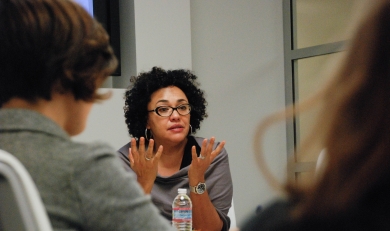Irvine Fellow Creates New Course on Arts and Cultures in Los Angeles Urban Planning alumna Maria Rosario-Jackson's new course is open to students in the humanities and Luskin.

By Alejandra Reyes-Velarde
UCLA Luskin student writer
Urban planning alumna Maria Rosario Jackson (PhD ’96) hopes to break boundaries in what it means to be an urban planner for students with a new course titled, “Arts & Culture in Communities: Implications for Planning, Design, Policy and Comprehensive Community Revitalization.” The new course integrates two worlds in the Los Angeles community and in her classroom by including students from both UCLA Luskin and the humanities.
Students enrolled in the course are from all three departments of the Luskin School, as well as degree programs in the humanities such as Chicana & Chicano studies, English literature, and World Arts and Cultures, among others. Jackson hopes that through the diverse and interdisciplinary nature of the course, students can learn from each other’s perspectives and knowledge in their field.
Jackson, who is a presidential appointee to the National Council on the Arts and senior advisor to the arts and cultural program at the Kresge Foundation, is teaching the course as a part of her new Irvine Fellowship sponsored by the James Irvine Foundation for the 2014-2015 academic year. As part of the fellowship, she will also be either hosting a series of community workshops or will be part of a public lecture in the winter or spring.
Her course teaches students to understand how arts and cultures in low-income and historically marginalized communities distinguish them from one another and gives them each a unique ‘pulse.’ Jackson said she developed an interest in the identity of racial, ethnic and other misrepresented groups as a young person growing up in Los Angeles and as an undergraduate student, which led her to pursue the subject in her career.
“You don’t really understand group identity until you start getting into what their aesthetic expressions are. The arts has always been a text for understanding communities,” she said.
Jackson said she thinks that strategies to address the collective uplift of marginalized groups are inherently inadequate if they don’t include the element of arts and cultures, which is often the case.
“If you look around the world and throughout the ages, in strategies to disempower and oppress a people a first step is to strip a community of its ability to make meaning and express themselves aesthetically and authentically,” she said. “So how can it not be part of efforts to strengthen them?”
Jackson said the class discusses how cultural and artistic objects, events and places can be interpreted as assets in a community and can be better understood as part of a solution for issues in distressed urban areas .
“It is an opportunity to explore and interrogate some emerging trends in urban planning and public policy that relate to the arts and figuring out how they work within the context of wanting to achieve more equitable outcomes,” she said.
Jackson said there are examples all over the country of artists who are working at the intersection of art and community revitalization and are helping to change the environment and social fabric of marginalized and low-income communities.
“Artists often help residents, who may not see themselves as artists, carry out artistic activity. Whether it is songwriting or theater, in the process of being creatively involved, residents are often treating the themes they are concerned with—health issues, fear of displacement, aspirations for better schools and jobs,” Jackson said. “Artists also can work with or as non-profit developers creating spaces and buildings far more interesting and meaningful than places without consideration for culture.”
In order to give students the opportunity to experience cultural assets in communities, they were instructed to explore a neighborhood in Los Angeles. For the project, Luskin and humanities students were paired together to encourage them to see the city in a different way that they normally would. After immersing themselves in the community, students were instructed to create a presentation that reported its cultural assets and critiques the extent to which they are evident in community improvement strategies.
Several speakers in the fields of art, urban planning, public policy and others have visited the class to have a discussion with students about projects they are working on.
Jackson said she accepted this fellowship because she thinks it is fulfilling and inspiring to be able to contribute to UCLA, her alma mater, with a new generation of people who want to improve Los Angeles. She also said she thinks this is an opportunity to explore and reconnect with her home after being away from Los Angeles for almost 20 years.

Leave a Reply
Want to join the discussion?Feel free to contribute!